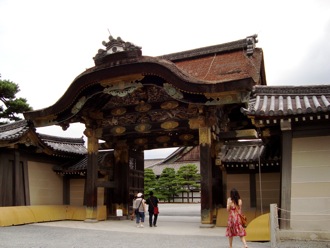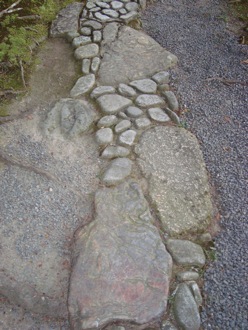In the morning, I visited three temple gardens that were close to each other but very different in style. First I went to the garden of Daisen-in, a Zen temple (part of the Daitoku-ji monastery). I had seen pictures of this garden but the reality was quite different. First of all, it was surprisingly small. Secondly, it was so vibrant and alive! The garden told a simple but profound story about the trajectory of our lives (the temple handed out a description of the symbolism).
On the downside, I was disappointed to discover that taking pictures of the garden was forbidden. There was a bogus rationale about the possibility of damage to the garden. But no other garden in Kyoto had this rule – it seemed financially motivated. I was sad because pictures were my way to remember the visit and to share my experiences with friends and family later.
But then on the positive side… When I had finished viewing the garden, a docent introduced me to the abbot of the temple, who was seated in the gift shop area. He looked kind of like the Dalai Lama – similar age, similar attire, short hair, jolly. I noticed his picture on the cover of one of the books they were selling. The abbott said some things which I did not understand, and then commenced to sing “We are the World”! He sang the whole song for me, with sheet music to guide him. I was charmed. At the end we laughed and expressed mutual appreciation. So the karma evened out. I didn’t get the photos, but I got a personal serenade from the abbott of a Zen temple.
The second garden I visited was the one belonging to Kinkakuji, the Golden Pavilion. This garden turned out to mainly be a lake with lots of little islands. The islands had rocks and small trees. The effect was beautiful. The Golden Pavilion itself was a building covered in gold foil, which I found rather garish.
The third garden I visited belonged to Ryōan-ji (the temple of the peaceful dragon), another Zen temple. This is a famous rock garden. It is nothing but clusters of rocks in raked gravel. It felt serene – the composition was perfectly balanced.
Part of what makes the rock garden work is that, if you go around the corner of the temple, you find yourself in front of a lush moss garden. So you can go back and forth between the two contrasting environments.
The rock garden is in a large temple complex that includes a lake with water lilies and other lovely landscapes.
I had lunch in the restaurant that was on the temple complex. It was another special meal. Again, yudofu was the house dish, and diners sat on tatami mats, looking out of big windows onto a beautiful garden. While I was eating, an elderly gardener started to work in front of the window. The symbolism seemed perfect – connecting me with the process of gardening.
In the afternoon, I went looking at crafts. First I went to the Nishijin Textile Center, where the art of silk weaving was displayed. I was not that interested. Then I went to the Kyoto Craft Center, which was kind of a boutique with many vendors. Mildly interesting. Finally, I went to the Morita Washi store, which sold origami paper. Bingo! I loved this place, and could have bought up the whole inventory. After much browsing, I purchased a number of sheets.




















